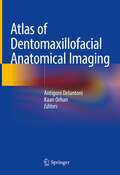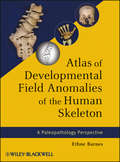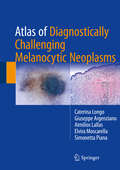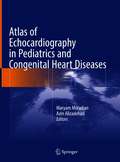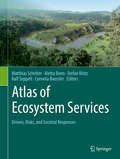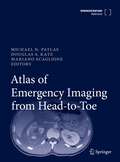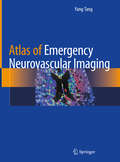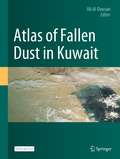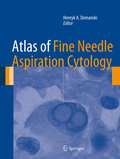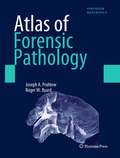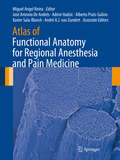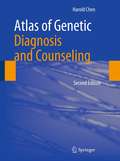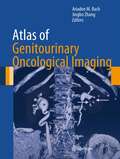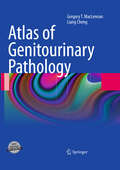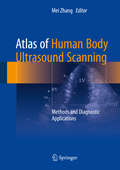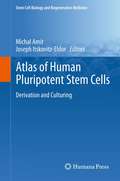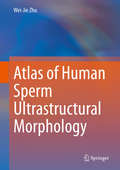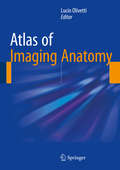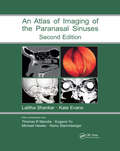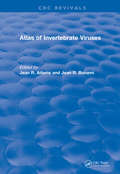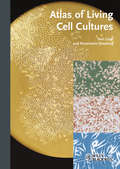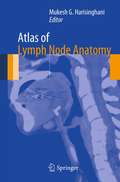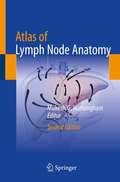- Table View
- List View
Atlas of Dentomaxillofacial Anatomical Imaging
by Antigoni Delantoni Kaan OrhanThis atlas is a detailed and complete guide on imaging of the dentomaxillofacial region, a region of high interest to a wide range of specialists. A large number of injuries and patient’s treatment involve the facial skeleton. Enriched by radiographic images and illustrations, this book explores the anatomy of this region presenting its imaging characteristics through the most commonly available techniques (MDCT, CBCT, MRI and US). In addition, two special chapters on angiography and micro-CT expand the limits of dentomaxillofacial imaging. This comprehensive book will be an invaluable tool for radiologists, dentists, surgeons and ENT specialists in their training and daily practice.
Atlas of Developmental Field Anomalies of the Human Skeleton
by Ethne BarnesWritten by one of the most consulted authorities on the subject, Atlas of Developmental Field Anomalies of the Human Skeleton is the pre-eminent resource for developmental defects of the skeleton. This guide focuses on localized bone structures utilizing the morphogenetic approach that addresses the origins of variability within specific developmental fields during embryonic development. Drawings and photographs make up most of the text, forming a picture atlas with descriptive text for each group of illustrations. Each section and subdivision is accompanied by brief discussions and drawings of morphogenetic development.
Atlas of Diagnostically Challenging Melanocytic Neoplasms
by Caterina Longo Giuseppe Argenziano Aimilios Lallas Elvira Moscarella Simonetta PianaThis atlas provides a clear, concise overview of the most challenging circumstances faced by clinicians and pathologists when dealing with melanocytic neoplasms. The book is structured as a case series; for each case, the clinical and dermoscopic appearances are presented, accompanied by a brief but comprehensive description and compelling histopathologic images. When available, in vivo confocal microscopy images are also included to highlight additional diagnostic clues. Identification of key messages and selected references will further guide the reader in the diagnosis and management of the neoplasm under consideration. It is well known that melanocytic lesions can be difficult to interpret. Some lesions show an ambiguous combination of morphologic criteria, and in these cases interpretation entails a high degree of subjectivity that results in low interobserver agreement even among expert pathologists. This atlas demonstrates how the addition of clinical information, including that provided by dermoscopy, can assist in reaching a more confident diagnosis.
Atlas of Echocardiography in Pediatrics and Congenital Heart Diseases
by Maryam Moradian Azin AlizadehaslThis atlas provides a practical guide to the diagnosis of congenital heart disease using echocardiography in both adults and children. A plethora of high-quality echocardiography images provide practical examples of how to diagnose a range of conditions correctly, including aortic stenosis, tricuspid atresia, coronary artery fistula and hypoplastic left heart syndrome. Atlas of Echocardiography in Pediatrics and Congenital Heart Diseases describes the diagnostic management of a range of congenital heart diseases successfully in both adults and children. Therefore it provides a valuable resource for both practicing cardiologists who regularly treat these patients and for trainees looking to develop their diagnostic skills using echocardiography.
Atlas of Ecosystem Services: Drivers, Risks, And Societal Responses
by Matthias Schröter Aletta Bonn Stefan Klotz Ralf Seppelt Cornelia BaesslerThis book aims to identify, present and discuss key driving forces and pressures on ecosystem services. Ecosystem services are the contributions that ecosystems provide to human well-being. The scope of this atlas is on identifying solutions and lessons to be applied across science, policy and practice. The atlas will address different components of ecosystem services, assess risks and vulnerabilities, and outline governance and management opportunities. The atlas will therefore attract a wide audience, both from policy and practice and from different scientific disciplines. The emphasis will be on ecosystems in Europe, as the available data on service provision is best developed for this region and recognizes the strengths of the contributing authors. Ecosystems of regions outside Europe will be covered where possible.
Atlas of Emergency Imaging from Head-to-Toe
by Michael N. Patlas Douglas S. Katz Mariano ScaglioneThis reference work provides a comprehensive and modern approach to the imaging of numerous non-traumatic and traumatic emergency conditions affecting the human body. It reviews the latest imaging techniques, related clinical literature, and appropriateness criteria/guidelines, while also discussing current controversies in the imaging of acutely ill patients. The first chapters outline an evidence-based approach to imaging interpretation for patients with acute non-traumatic and traumatic conditions, explain the role of Artificial Intelligence in emergency radiology, and offer guidance on when to consult an interventional radiologist in vascular as well as non-vascular emergencies. The next chapters describe specific applications of Ultrasound, Magnetic Resonance Imaging, radiography, Multi-Detector Computed Tomography (MDCT), and Dual-Energy Computed Tomography for the imaging of common and less common acute brain, spine, thoracic, abdominal, pelvic and musculoskeletal conditions, including the unique challenges of imaging pregnant, bariatric and pediatric patients. Written by a group of leading North American and European Emergency and Trauma Radiology experts, this book will be of value to emergency and general radiologists, to emergency department physicians and related personnel, to obstetricians and gynecologists, to general and trauma surgeons, as well as trainees in all of these specialties.
Atlas of Emergency Neurovascular Imaging
by Yang TangIschemic and hemorrhagic strokes are common neurological emergencies. In recent years, endovascular intervention has become a standard of care in treating acute ischemic stroke, aneurysms, and vascular malformations. As a result, noninvasive CT- and MRI-based techniques have been increasingly used in emergency settings. In this context, neurovascular imaging has become an essential part of the curriculum for training emergency radiologists, stroke neurologists, and vascular neurosurgeons. This book provides a comprehensive review of the entire spectrum of emergent neurovascular imaging, with the emphasis on noninvasive CT angiography (CTA), MR angiography (MRA), and perfusion techniques. It is organized into 11 chapters. The first three chapters address the topics of acute stroke imaging, including algorithms based on recent clinical trials and updated American Heart Association stroke guideline, vascular territories, and stroke mimics. These are followed by discussions of cerebrovenous thrombosis, vasculopathies, aneurysms, and vascular malformations. Remaining chapters are devoted to the traumatic neurovascular injury, as well as the relatively rare albeit important topics of head and neck vascular emergencies and spinal vascular diseases. The book has an image-rich format, including more than 300 selected CT, MRI, or digital subtraction angiography (DSA) images. Atlas of Emergency Neurovascular Imaging is an essential resource for physicians and related professionals, residents, and fellows in emergency medicine, neuroradiology, emergency imaging, neurology, and vascular neurosurgery and can successfully serve as a primary learning tool or a quick reference guide.
Atlas of Fallen Dust in Kuwait
by Ali Al-DousariThis open access book serves as an atlas of deposited dust and dust storms in Kuwait in relation to local and global regions. It features a wealth of maps and images of dust storm trajectories in the region, together with detailed descriptions of the chemical and physical properties of fallen dust, including the amount, particle size, statistical parameters, spectra absorption, dust mineralogy, trace and major elements, organic matter, associated pollen, and radionuclides and connected pollutants. Given its scope, the book is a valuable resource for a broad range of researchers, including geologists, chemists, environmentalists, botanists, air quality specialists, nanotechnology scientists, and solar energy experts.
Atlas of Fine Needle Aspiration Cytology
by Henryk A. DomanskiThis book covers all of the diagnostic areas where FNAC is used today. This includes palpable lesions and lesions sampled using various radiological methods, and correlations with ancillary examinations detailed on an entity-by-entity basis. As well as being a complete atlas of the facts and findings important to FNAC, this atlas is a guide to diagnostic methods that optimize health care. The interaction of the cytologist or cytopathologist with other specialists (radiologists, oncologists and surgeons) involved in the diagnosis and treatment of patients with suspicious mass lesions is emphasized and illustrated throughout. With contributions from experts in the field internationally and abundant colour images Atlas of Fine Needle Aspiration Cytology provides a comprehensive and up-to-date guide to FNAC for pathologists, cytopathologists, radiologists, oncologists, surgeons and others involved in the diagnosis and treatment of patients with suspicious mass lesions.
Atlas of Forensic and Criminal Psychology
by Bernat-N. TiffonOriginally published in Spanish in 2017 by Libreria Bosch, Barcelona, the Atlas of Forensic and Criminal Psychology is a one-of-kind book made available in English for the first time. This unique work is highly illustrated with full-color images, providing a medico-legal examination of forensic pathology as it relates to cases of forensic psychological interest. The book begins with a historical perspective and includes images of patients to familiarize the reader with symptoms, the hazard-risk criteria, lethality, and suicidal rescue—research that Dr. Tiffon has addressed in his previous publications. Chapters present photographic records of cases to deepen forensic, psychologist, and medico-legal professionals’ insight into thoughts, behaviors, and mechanisms of self- and hetero-aggressiveness. Such cases illustrate the outcomes of various disorders manifested in individuals and victims; as such, they provide an understanding of the psychological-legal conclusions reached in such cases in order to adapt the legal and preventative measures for specific situations. Coverage includes affective, schizophrenic, and personality disorders as contributing elements in diagnostic judgments, noting the great difficulty such examples present to experts performing psychopathological evaluations after criminal, and often violent, events have occurred. Various psychopathological disorders are addressed as well as the technical treatment that should occur in each case from a psychological-forensic perspective. Features: • Presents a provocative look at various syndromes familiar to forensic psychologists, as applied to criminal cases and the pathology of suicide victims and homicide perpetrators • Combines the work of world-renowned expert contributors to examine the criminal, legal, and psychological facets of various diagnoses and case examples • Offers insight into the psychological state of suicide victims, considering their state of mind as a "psychological autopsy" In his previous books published in Spanish, Manual of Consulting in Psychology and Clinical, Legal, Legal, Criminal, and Forensic Psychopathology (2008), Manual of Professional Performance in Clinical, Criminal, and Forensic Psychopathology (2009), and the 4-volume Practical Criminological Atlas of Forensic Psychometry (2019-2020), Tiffon approached forensic psychology and psychopathology from a theoretical perspective. In the Atlas of Forensic and Criminal Psychology, his first book translated into English, Tiffon expands on these prior works, serving to provide a visual reference and guide to medical pathologists and consulting psychologists in cases of disorders in which psychopathological mutilation, injury, and self-injury occur.
Atlas of Forensic Pathology: For Police, Forensic Scientists, Attorneys, and Death Investigators
by Roger W. Byard Joseph A. PrahlowThe Atlas of Forensic Pathology, For Police, Forensic Scientists, Attorneys and Death Investigators is a Major Reference Work that is specifically is designed for non-pathologists who normally interact with forensic pathologists. Chapters 1 through 6 will provide background information regarding medicine, pathology, forensic pathology, death investigation, cause, manner and mechanism of death, death certification, and anatomy and physiology. The next 3 chapters will deal with general topics within forensic pathology, including the forensic autopsy, postmortem changes and time of death, and body identification. Chapters 10 through 20 will detail the major types of deaths encountered by forensic pathologists, including natural deaths, drug/toxin deaths, blunt force injuries, gunshot wounds, sharp force injuries, asphyxia, drowning, electrocution, temperature-related injuries, burns and fires, and infant/childhood deaths. The final chapter includes brief descriptions dealing with various miscellaneous topics, such as in-custody deaths, homicidal deaths related to underlying natural disease, and artifacts in forensic pathology. This atlas differs from competition in that no atlas currently exists that address material for non-pathologists (detectives, forensic entomologists and pathologists), who normally interact with forensic pathologists. The book will present such images that are or interest to not only forensic pathologists but also of interest to odontology, anthropology, crime scene investigators, fingerprints specialists, DNA specialists and entomologists, etc. The competing atlases present images of interest mostly to medical examiners, forensic pathologists and pathologists and consist mostly of wounds, and trauma with some coverage of diseases. The color photographs will come from the collection of over 50,000 slides in the Adelaide Australia collection and some 100,000 slides from the collection compiled by Dr. Prahlow that includes slides from Cook County, Indianapolis, and North Carolina.
Atlas of Functional Anatomy for Regional Anesthesia and Pain Medicine: Human Structure, Ultrastructure and 3D Reconstruction Images
by Miguel Angel Reina José Antonio De Andrés Admir Hadzic Alberto Prats-Galino Xavier Sala-Blanch André A.J. van ZundertThis is the first atlas to depict in high-resolution images the fine structure of the spinal canal, the nervous plexuses, and the peripheral nerves in relation to clinical practice. The Atlas of Functional Anatomy for Regional Anesthesia and Pain Medicine contains more than 1500 images of unsurpassed quality, most of which have never been published, including scanning electron microscopy images of neuronal ultrastructures, macroscopic sectional anatomy, and three-dimensional images reconstructed from patient imaging studies. Each chapter begins with a short introduction on the covered subject but then allows the images to embody the rest of the work; detailed text accompanies figures to guide readers through anatomy, providing evidence-based, clinically relevant information. Beyond clinically relevant anatomy, the book features regional anesthesia equipment (needles, catheters, surgical gloves) and overview of some cutting edge research instruments (e. g. scanning electron microscopy and transmission electron microscopy). Of interest to regional anesthesiologists, interventional pain physicians, and surgeons, this compendium is meant to complement texts that do not have this type of graphic material in the subjects of regional anesthesia, interventional pain management, and surgical techniques of the spine or peripheral nerves.
Atlas of Genetic Diagnosis and Counseling
by Harold ChenDr. Chen shares his almost 40 years of clinical genetics practice in a comprehensive pictorial atlas of almost 250 genetic disorders, malformations, and malformation syndromes. The author provides a detailed outline for each disorder, describing its genetics, basic defects, clinical features, diagnostic tests, and counseling issues, including recurrence risk, prenatal diagnosis, and management. Numerous color photographs of prenatal ultrasounds, imagings, cytogenetics, and postmortem findings illustrate the clinical features of patients at different ages, patients with varying degrees of severity, and the optimal diagnostic strategies. The disorders cited are supplemented by case histories and diagnostic confirmation by cytogenetics, biochemical, and molecular techniques, when available. The Atlas of Genetic Diagnosis and Counseling will help all physicians to understand and recognize genetic diseases and malformation syndromes and better evaluate, counsel, and manage affected patients. In this new edition, 47 additional genetic disorders are added, as well as extensive updates made to the previous disorders. New illustrations, as previous edition, will be supplemented by case and family history, clinical features, and laboratory data, especially molecular confirmation.
Atlas of Genitourinary Oncological Imaging (Atlas of Oncology Imaging #1)
by Ariadne M Bach Jingbo ZhangThe Atlas of Genitourinary Oncological Imaging presents a comprehensive visual review of appearances for normal anatomy and oncological diseases in the genitourinary system using over 900 radiological images and illustrations. The book presents current imaging techniques and discusses the role of imaging in pre-treatment staging and post-treatment follow-up. Diseases discussed include kidney, adrenal gland, upper tract, bladder, prostate, testes, and pediatric malignancies. Individual chapters include normal anatomy, imaging techniques, and pathology of each cancer type. The staging of the malignancy and what to include in the radiology report are discussed, and expected and complicated postoperative and post-treatment findings and recurrence are presented. Dedicated chapters on interventional and radiation therapy discuss their unique role in the management and treatment of oncology of the genitourinary system. Additionally, a chapter on chemotherapy toxicities discusses drug reaction treatment therapies unique to the genitourinary system. Edited and written by radiologists from the genitourinary disease management team at Memorial Sloan-Kettering Cancer Center, the Atlas of Genitourinary Oncological Imaging is an ideal resource for radiology and urology trainees seeking a review of the basics and for practicing radiologists looking for answers to challenging cases confronted in daily practice.
Atlas of Genitourinary Pathology
by Liang Cheng Gregory T. MaclennanA single source of information about pathologic lesions of the adrenal, the urinary tract, and the male genital system, minimizing the need to consult numerous texts of limited scope, this book contains gross photos and photomicrographs of virtually every pathologic entity, and variants of those entities. The book is lavishly illustrated with images accompanied by text that explains the visual images, highlighting key diagnostic features and providing brief but helpful discussions of the differential diagnosis. This book is designed for practicing pathologists and pathologists in training as well as urologists, GU radiologists, GU radiation oncologists, and GU medical oncologists.
Atlas of Great Comets
by Ronald StoyanThroughout the ages, comets, enigmatic and beautiful wandering objects that appear for weeks or months, have alternately fascinated and terrified humankind. The result of five years of careful research, Atlas of Great Comets is a generously illustrated reference on thirty of the greatest comets that have been witnessed and documented since the Middle Ages. Special attention is given to the cultural and scientific impact of each appearance, supported by a wealth of images, from woodcuts, engravings, historical paintings and artifacts, to a showcase of the best astronomical photos and images. Following the introduction, giving the broad historical context and a modern scientific interpretation, the Great Comets feature in chronological order. For each, there is a contemporary description of its appearance along with its scientific, cultural and historical significance. Whether you are an armchair astronomer or a seasoned comet-chaser, this spectacular reference deserves a place on your shelf.
Atlas of Human Body Ultrasound Scanning: Methods and Diagnostic Applications
by Mei ZhangThis atlas describes the diagnosis practice and cases of human body ultrasound. It includes anatomic section, standard scan ultrasonogram of every organ, scanning methods and key points, measurement methods, normal value ranges, and clinical significances of every sections. Providing basic information and fundamental principles of ultrasonic diagnosis, it discusses ultrasound scanning of 14 organs in individual chapters. Each section sonography is accompanied by the scanning method, section structure, measuring method and clinical application. The uniform structure and detailed instructions make this atlas an easy-to-use resource for residents to refer to when they encounter specific ultrasound diagnostic problems.
Atlas of Human Pluripotent Stem Cells: Derivation and Culturing (Stem Cell Biology and Regenerative Medicine)
by Michal Amit Joseph Itskovitz-EldorHuman pluripotent stem cells, including human embryonic stem cells and induced pluripotent stem cells, are a key focus of current biomedical research. The emergence of state of the art culturing techniques is promoting the realization of the full potential of pluripotent stem cells in basic and translational research and in cell-based therapies. This comprehensive and authoritative atlas summarizes more than a decade of experience accumulated by a leading research team in this field. Hands-on step-by-step guidance for the derivation and culturing of human pluripotent stem cells in defined conditions (animal product-free, serum-free, feeder-free) and in non-adhesion suspension culture are provided, as well as methods for examining pluripotency (embryoid body and teratoma formation) and karyotype stability. The Atlas of Human Pluripotent Stem Cells - Derivation and Culturing will serve as a reference and guide to established researchers and those wishing to enter the promising field of pluripotent stem cells.
Atlas of Human Sperm Ultrastructural Morphology
by Wei-Jie ZhuThis atlas provides ultrastructural morphological images of human spermatozoa. Sperm morphology plays an essential role in sperm-oocyte interactions and early embryonic development, and human sperm ultrastructural morphology offers a valuable reference tool for assessing certain etiologies of male infertility and reproductive failure. However, the ultrastructural morphology of human sperm has not been systematically evaluated or thoroughly described in the literature. Using 470 original and unpublished images, the book shows various ultrastructural morphological phenotypes; defects of the sperm head, neck, middle piece, principal piece, and terminal piece; as well as artefacts of sperm ultrastructural morphology and phenomena related to inadequate preparation, demonstrating many sperm phenotypes and surface structural appearances for the first time. As such, it helps researchers and practitioners in andrology, reproductive medicine, and reproductive pathology gain a better understanding of human sperm ultrastructural morphology.
Atlas of Imaging Anatomy
by Lucio OlivettiThis book is designed to meet the needs of radiologists and radiographers by clearly depicting the anatomy that is generally visible on imaging studies. It presents the normal appearances on the most frequently used imaging techniques, including conventional radiology, ultrasound, computed tomography, and magnetic resonance imaging. Similarly, all relevant body regions are covered: brain, spine, head and neck, chest, mediastinum and heart, abdomen, gastrointestinal tract, liver, biliary tract, pancreas, urinary tract, and musculoskeletal system. The text accompanying the images describes the normal anatomy in a straightforward way and provides the medical information required in order to understand why we see what we see on diagnostic images. Helpful correlative anatomic illustrations in color have been created by a team of medical illustrators to further facilitate understanding.
Atlas of Imaging of the Paranasal Sinuses, Second Edition
by Kate Evans, Thomas R. Marotta, Eugene Yu, Michael Hawke and Heinz StammbergerWith color illustrations, the Second Edition of this best-selling guide concentrates on the advances in technology that are now available to the clinical otolaryngologist. This reinforces the book's position as a classic guide, especially to the problems associated with endoscopic sinus surgery.
Atlas of Invertebrate Viruses: Atlas Of Invertebrate Viruses (1991) (CRC Press Revivals)
by Jean R. Adams Jean R. BonamiThe Purpose of this book is to provide a helpful reference for invertebrate pathologist, virologists, and electron microscopists on invertebrate viruses. Investigators from around the world have shared their expertise in order introduce scientists to the exciting advances in invertebrate virology.
Atlas of Living Cell Cultures
by Rosemarie Steubing Toni LindlThe first atlas in many years giving researchers a good visual reference of the status of their cell lines. Given the increasing importance of well defined cellular models in particular in biomedical research this is a sorely needed resource for everyone performing cell culture.
Atlas of Lymph Node Anatomy
by Mukesh G. HarisinghaniDetailed anatomic drawings and state-of-the-art radiologic images combine to produce this essential Atlas of Lymph Node Anatomy. Utilizing the most recent advances in medical imaging, this book illustrates the nodal drainage stations in the head and neck, chest, and abdomen and pelvis. Also featured are clinical cases depicting drainage pathways for common malignancies. 2-D and 3-D maps offer color-coordinated representations of the lymph nodes in correlation with the anatomic illustrations. This simple, straightforward approach makes this book a perfect daily resource for a wide spectrum of specialties and physicians at all levels who are looking to gain a better understanding of lymph node anatomy and drainage. Edited by Mukesh G. Harisinghani, MD, with chapter contributions from staff members of the Department of Radiology at Massachusetts General Hospital.
Atlas of Lymph Node Anatomy
by Mukesh G. HarisinghaniThis book is a comprehensive atlas on lymph node anatomy and drainage to aid in cancer staging and therapy. Nodal drainage is pertinent to all aspects of cancer staging and therapy and is used by radiation oncologists, surgeons, and medical oncologists to increase accuracy. The first edition of this text was the first comprehensive monograph on this topic, allowing physicians across various specialties to utilize this information and easily share that knowledge with residents, fellows, and junior faculty.Detailed anatomic drawings and state-of-the-art radiologic images combine to produce this essential Atlas of Lymph Node Anatomy. Utilizing the most recent advances in medical imaging, this book illustrates the nodal drainage stations in the head and neck, chest, abdomen, and pelvis. Also featured are clinical cases depicting drainage pathways for common malignancies. 2-D and 3-D maps offer color-coordinated representations of the lymph nodes in correlation with the anatomic illustrations. This simple, straightforward approach makes this book a perfect daily resource for a wide spectrum of specialties and physicians at all levels who are looking to gain a better understanding of lymph node anatomy and drainage.This new edition enables physicians to educate themselves on the location of various nodal stations, especially in the context of common primary tumors, so that they are able to detect, localize, and characterize nodes seen with novel new imaging methods and with an increased level of accuracy. Chapters now cover the significant strides made in the imaging realm, such as PET CT, conventional MRI, MRI with novel imaging agents, and multidetector CT, which allows visualization of lymph nodes in various anatomic compartments.
